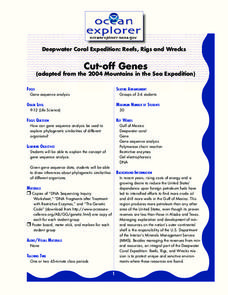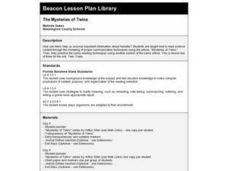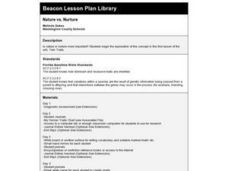Curated OER
How Unique Are You?
Students explore how genetic information is passed down from parent to offspring. Because of this, they examine how this causes the variation in each species.
Curated OER
Genes and Inheritance
Students explore genes and inheritance. After listening to a story describing a rare genetic disease, students discuss inheritance and how living things pass on traits to their children. In groups students, students decipher code...
Curated OER
Meiosiss Revisited
Seventh graders are engaged in a lesson that covers the concept of meiosis with the intention of covered sexual reproduction. They cover the concept of genetic traits and how they are transmitted over generations with or without...
Curated OER
Are You Related?
Students study microsatellite markers and explain how they might be used to identify populations. They use data to make inferences about the populations of deep-sea corals.
Curated OER
Ladders of Life
Students explore the field of genetics. They examine four basic traits. Students demonstrate their knowledge of phenotype and genotype by charting their personal traits. Students compelte a Meiosis chart. From the chart results,...
Curated OER
Finding, Gathering, Saving Seeds
Young scholars understand the importance of saving seeds. In this saving seeds lesson, students dry out seeds for later use planting. Young scholars recognize that one plant may have many seeds.
Curated OER
Pesticide Watch Card
Students examine human health by identifying dangerous pesticides. In this agriculture lesson, students research the food production system in the United States and discuss dangers such as pesticides, chemicals and insecticides which...
Curated OER
Cut-off Genes
Investigate the relationships between different deep-sea organisms by DNA sequencing. A worksheet provides instructions for DNA sequencing and space to work. They simulate gel electrophoresis by cutting out paper "DNA strands." Modeling...
Curated OER
DNA Detectives
Fifth graders define dominant and recessive genes and that they have DNA from their mother and father. In this inherited traits lesson, 5th graders complete a punnet square based on their parents traits. Students decorate their Punnet...
Curated OER
Lesson on Proteins
Students examine the importance of proteins including their function and structure. In this protein lesson students play a game to help them better understand proteins.
Curated OER
Pendemonium Unnatural Selection: Quotation Marks
Students practice the correct use of quotation marks. In this grammar lesson, students watch and then discuss a video on the use of quotation marks. Students find examples of quotation marks in books and periodicals and then convert...
Curated OER
Cutt-Off Genes
High schoolers explore how gene sequence analysis can be used to examine phylogenetic similarities of different organisms. Students work in groups to simulate a gel electrophoresis separation of fragments using poster board to create...
Curated OER
Cut-Off Genes
Students explain the concept of gene sequence analysis. In this gene lesson, students draw inferences about phylogenetic similarities of different organisms.
Curated OER
Principles of Heredity
Students model traits on genes using colored paper and tongue depressors to represent chromosomes. In this heredity lesson plan, students use their "chromosome sticks" to understand chromosome pairs, genes, dominant traits, recessive...
Curated OER
Diversity
Students access prior knowledge of the five senses and relate to students with disabilities. In this people with disabilities lesson, students research and use a Venn diagram to compare and contrast famous people and their...
Curated OER
The Circle of Life: Food Chain
Students develop a flow chart using computer software to show a food chain combination. In this food chain instructional activity, students are first read The Great Kapok Tree by Lynne Cherry, then they create a story map of the story. ...
Curated OER
The Mysteries of Twins
Third graders experience reading in the content areas by reading about heredity and practicing summarizing the reading.
Curated OER
GM Foods: Are They Safe?
Students examine the process for testing GM foods. They research benefits and hazards of a selection of GM foods. They also create images of new labels and marketing for GM foods.
Curated OER
Square Dancing
Fourth graders investigate the concept of using punnett squares in the determination of the offspring.They collect drawings and pictures and create a collection for student science journals.
Curated OER
EMS Lesson 2: Outrageous Offspring
Students investigate the principles of probability that can be used to predict hereditary traits.
Curated OER
Nature vs. Nurture
Eighth graders investigate the concept of nature versus nurture in human development through this series of lessons.
Curated OER
Decoding DNA
Third graders complete their KWL charts from the first lesson of the unit as a review for the summative. Then they decode a secret message using the four basic components of DNA, adenine, cytosine, guanine and thymine.
Curated OER
Bioregions of California
Learners map out the bioregions of California by examining the species and environment in different areas of the state. They use information and pictures from a PowerPoint presentation to complete a map handout and play a trivia game.
Curated OER
Invent PCR: You May Win a Nobel Prize
Students gain an appreciation for the simplicity, but also complexity and elegance of PCR. They comprehend all components of the protocol. Students explain exactly how CPR works, and why, after the third cycle, the predominant DNA being...

























